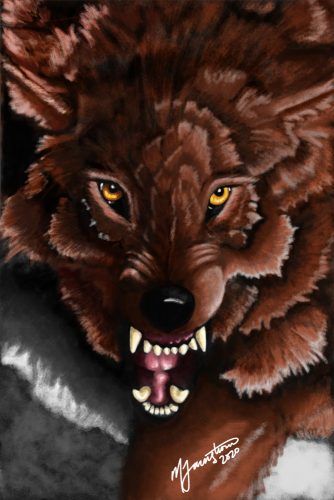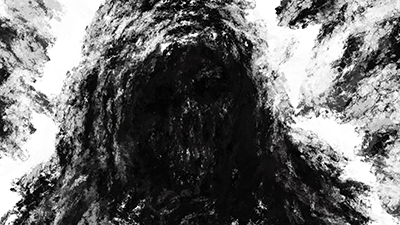The frontier of the far north is typically regarded with mystery and a sense of trepidation. Even if you have lived through it all, there is always something about the place that can feel rather unsettling. The standardized phobia of the dark is exacerbated by the long, cold winters of Alaska—a place where nearly half the year is shrouded in the dark bitter cold. Those of us who live in a place that is constantly trying to kill us can attest to the harshness of the environment, at least during the winter, where temperatures often plummet to thirty degrees below freezing. To say that the cold and dark are our sole worries would be a farce, but that’s only because we have all heard the stories about what lurks in the darkness of the Last Frontier.
Don’t be mistaken—you don’t have to be a Sourdough to be wary of the beasts abound in the frozen tundra. Stay for a couple of days in a rural cabin during the darkest part of the year and you’ll soon be wondering if those are really are the eyes of the Adlet glimmering at you from the shadows, or if it’s just light shining off of the crystalized snow. Was that shadow under the the water the Tizheruk or something else? Turn your back and you’ll likely feel as if you’re being watched by a deadly monster waiting to attack.
The Monsters of Alaska Native Culture
Every culture has its own unique beasts that torment the locals—the farther you get out of the urban atmosphere, the closer you get to what keeps people from roaming unnecessarily into the shadows.

1. The Adlet: The Werewolf of the Far North
The murderous Adlet is considered the arctic counterpart to the well-known werewolf. Believed to be the unholy descendants of an Inuit woman and a dog, they have an upper body of their human brethren, but their lower half is fully canine. They are considered to be a full-fledged race of humanoids, who after their initial creation were sent to a remote island away from humans, so as not to satiate themselves on local tribes—except that didn’t last.

2. The Keelut: The Evil Earth Spirit
A mixture between a cryptid and the paranormal spirit—the Keelut (key-loot) is considered an earth spirit who primarily takes the shape of an immense black, hairless dog. It’s often compared to the Church Grim of Great Britain and stalks travelers at night, often attacking and killing them.

3. The Qalupalik: The Inuit Siren
If you live by the arctic ocean you will have undoubtedly heard about the Qalupalik (kah-loo-pah-lick), a creature that stems from Inuit culture and haunts the nights of children as they’re sleeping. She’s described as being humanoid, with green skin, long hair, and even longer fingernails. Like a siren, her home is the sea and she hums to lure children to come closer to the water, but what does she do with them?

4. The Thunderbird: An Avian Nightmare
From Southern Alaska all the way to the Pacific Northwest, there are legends that speak of the mythical Thunderbird. As large as a small plane, stories have been told by Natives as well as bush pilots who can confirm the existence of such a monster. Considering the reputation that even the bald eagle has for snatching up small dogs, it’s not too much of a stretch to fear for your children with such a gigantic vicious bird of prey in the skies above.

5. The Tizheruk: The Sea-Monster of the Arctic
Not unlike the lore that brings us Loch Ness, the Tizheruk (te-zer-ook) is described as being a sea serpent that is approximately fifteen feet long. Where Loch Ness is considered to be less of a threat and more of a mystery, the Tizheruk is known to snatch their unwitting victims from docks and piers.

6. The Tornit: The Alaskan Bushman
Even Alaska has its own legends about Bigfoot—we reference it as the Tornit (tore-nit), or the Alaskan Bushman. Another monster from Inuit folklore, the Tornit is nearly indistinguishable from a bear except for the ghastly skunk-like smell they exude. They mostly keep to themselves out in the bush, after their troubled history dealing with humans, who can blame them?
Read our original story about this beast and his fateful encounter with an Inuit boy.

7. Kushtaka: The Otter People
The Otter People are most often seen in the Pacific Northwestern region of Alaska known as the Kushtaka. These tall, ape-like creatures are known to be aggressive and deadly and chase and kill their victims. Described as being horribly ugly, covered in long coarse hair, scabs, scars, and have enormously long claws. Their scream is high-pitched and terrifying, they have a strange whistling call that also alerts people to their presence.

Georgia-based author and artist, Mary has been a horror aficionado since the mid-2000s. Originally a hobby artist and writer, she found her niche in the horror industry in late 2019 and hasn’t looked back since. Mary’s evolution into a horror expert allowed her to express herself truly for the first time in her life. Now, she prides herself on indulging in the stuff of nightmares.
Mary also moonlights as a content creator across multiple social media platforms—breaking down horror tropes on YouTube, as well as playing horror games and broadcasting live digital art sessions on Twitch.
